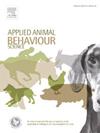Development of a scale to assess pigs’ immediate behavioural reaction when encountering novel odours
IF 2
2区 农林科学
Q1 AGRICULTURE, DAIRY & ANIMAL SCIENCE
引用次数: 0
Abstract
It is currently not possible to predict how pigs will perceive novel odours, or whether certain odours might evoke avoidant or exploratory behavioural reactions. This study aimed to develop a reaction scale to assess the immediate behavioural reactions of pigs when encountering an odour for the first time. A secondary aim was to compare if reactions to different odours varied consistently among pigs, which could indicate that the reaction scale could be used to assign odour valence. The experiment included 184 growing-finishing pigs tested in 92 pairs of opposite-sex littermates. All pig pairs were presented with three out of a total of twelve different odours, in a balanced order. The odour samples consisted of six drops of essential oils (undiluted) on filter paper in a plastic container. Each of the three odours was presented along with an odourless control (distilled water). The odour and control samples were available to the pigs during 1-minute trials. The pigs’ behavioural reactions were recorded six seconds after each pig had first approached the sample. The reaction was scored on a scale from 1 to 6, where 1 was exploratory behaviour (e.g., sniffing) and 6 was active avoidance behaviour (e.g., leaving, head shaking). An ordinal mixed-effects model was fitted to the data and showed no effect of sex, age, or odour triad on reaction scores, but an effect of treatment with odour eliciting significantly more exploratory behaviour (lower reaction score) than control (P < 0.001). Pigs expressed large individual differences in reactions to 10 of the 12 odours, but a consistent pattern of significantly more exploratory reactions to vanilla and blood orange (both odours: P < 0.05), which could suggest that pigs may perceive these odours as particularly pleasant. Reaction scores were significantly lower (i.e., pigs performing more explorative behaviour) for the first odour tested compared with subsequent odours (P ≤ 0.04) irrespective of the specific odour. The 6-point scale effectively described explorative and avoidance behaviours that may reflect the valence of the pigs’ reactions. To our knowledge, this is the first scale specifically developed to assess pigs’ immediate behavioural reactions to novel olfactory stimuli in a commercial production environment. The development of the reaction scale and the findings provide useful guidance for future research on odour perception. The observed decrease in interest over time should be taken into account when repeated testing is used.
开发一种评估猪在遇到新奇气味时的即时行为反应的量表
目前还不可能预测猪将如何感知新奇的气味,或者某些气味是否会引起回避或探索的行为反应。本研究旨在开发一种反应量表来评估猪在第一次遇到气味时的即时行为反应。第二个目的是比较猪对不同气味的反应是否一致,这可能表明反应量表可以用来分配气味价。该实验包括184头生长肥育猪,在92对异性窝中进行测试。所有对猪都被按顺序从12种不同的气味中挑选出3种。气味样本包括六滴精油(未稀释)在滤纸上,放在一个塑料容器中。这三种气味中的每一种都与无味的对照物(蒸馏水)一起呈现。在1分钟的试验中,猪可以获得气味和对照样本。在每头猪第一次接近样本6秒后,记录下它们的行为反应。该反应的评分范围从1到6,其中1是探索性行为(例如,嗅探),6是主动回避行为(例如,离开,摇头)。对数据拟合了一个有序混合效应模型,结果显示性别、年龄或气味三合一因素对反应得分没有影响,但气味处理的效果明显比对照组引起更多的探索行为(较低的反应得分)(P <; 0.001)。猪对12种气味中的10种的反应表现出很大的个体差异,但对香草和血橙(两种气味:P <; 0.05)的反应明显更具探索性,这可能表明猪可能认为这些气味特别令人愉快。与随后的气味相比,第一种气味的反应得分明显较低(即,猪表现出更多的探索行为)(P ≤ 0.04),而不考虑具体的气味。6分制有效地描述了可能反映猪反应效价的探索和回避行为。据我们所知,这是第一个专门用于评估猪在商业生产环境中对新型嗅觉刺激的即时行为反应的量表。反应量表的开发和研究结果为今后气味感知的研究提供了有益的指导。当使用重复测试时,应该考虑到观察到的兴趣随时间的减少。
本文章由计算机程序翻译,如有差异,请以英文原文为准。
求助全文
约1分钟内获得全文
求助全文
来源期刊

Applied Animal Behaviour Science
农林科学-行为科学
CiteScore
4.40
自引率
21.70%
发文量
191
审稿时长
18.1 weeks
期刊介绍:
This journal publishes relevant information on the behaviour of domesticated and utilized animals.
Topics covered include:
-Behaviour of farm, zoo and laboratory animals in relation to animal management and welfare
-Behaviour of companion animals in relation to behavioural problems, for example, in relation to the training of dogs for different purposes, in relation to behavioural problems
-Studies of the behaviour of wild animals when these studies are relevant from an applied perspective, for example in relation to wildlife management, pest management or nature conservation
-Methodological studies within relevant fields
The principal subjects are farm, companion and laboratory animals, including, of course, poultry. The journal also deals with the following animal subjects:
-Those involved in any farming system, e.g. deer, rabbits and fur-bearing animals
-Those in ANY form of confinement, e.g. zoos, safari parks and other forms of display
-Feral animals, and any animal species which impinge on farming operations, e.g. as causes of loss or damage
-Species used for hunting, recreation etc. may also be considered as acceptable subjects in some instances
-Laboratory animals, if the material relates to their behavioural requirements
 求助内容:
求助内容: 应助结果提醒方式:
应助结果提醒方式:


